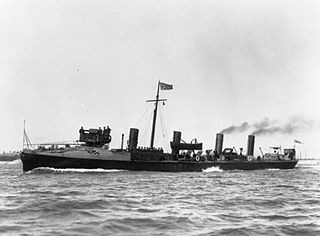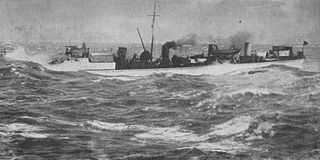
The Havock class was a class of torpedo boat destroyer (TBD) of the British Royal Navy. The two ships, Havock and Hornet, built in London in 1893 by Yarrow & Company, were the first TBDs to be completed for the Royal Navy, although the equivalent pair from J.I. Thornycroft, Daring and Decoy, were ordered five days earlier.

HMS Havock was a Havock-class torpedo boat destroyer of the British Royal Navy built by the Yarrow shipyard. She was one of the first destroyers ordered by the Royal Navy, and the first to be delivered.

Two Daring-class destroyers were the very first torpedo boat destroyers ("TBDs") to be ordered for the Royal Navy, the order being placed on 27 June 1892.

Two Ferret-class destroyers served with the Royal Navy. Ferret and Lynx were built by Laird, displaced 280 tons and were 199 feet (61 m) in overall length.

The three Ardent-class torpedo boat destroyers were ordered by the British Admiralty on 12 October 1893 and served with the Royal Navy. Built by Thornycroft for a contract price of £110,520 for all three vessels, they displaced 301 tons fully laden, and were 201 feet 8 inches (61.47 m) long overall.

HMS Ardent was a Royal Navy 27 knot torpedo boat destroyer ordered from John I Thornycroft & Company under the 1893 – 1894 Naval Estimates. She was the sixth ship to carry this name.

The three Charger-class destroyers were all ordered by the British Admiralty on 12 October 1893 and on completion in early 1896 they served with the Royal Navy until 1911.

HMS Charger was a Charger-class destroyer which served with the Royal Navy. She was launched by Yarrow Shipbuilders at Poplar, London on 15 September 1894, served in home waters and was sold off in 1912.
HMS Hasty was a Charger-class destroyer which served with the Royal Navy. She was launched by Yarrow Shipbuilders in 1894, served in home waters and was sold off in 1912.

HMS Dasher was a Charger-class destroyer which served with the Royal Navy. She was built by Yarrow Shipbuilders in 1895, served in home waters and was sold in 1911.
HMS Hardy was a Hardy-class destroyer which served with the Royal Navy. She was built by William Doxford & Sons in 1895, launched on 16 December 1895, and sold off on 11 July 1911.
HMS Haughty was a Hardy-class destroyer which served with the Royal Navy. She was launched by William Doxford & Sons on 18 September 1895, served in home waters, and was sold on 10 April 1912.

HMS Lynx was a Ferret-class destroyer which served with the Royal Navy. She was launched in 1894 and sold in 1912.

HMS Banshee was one of three Banshee-class destroyers which served with the Royal Navy.
HMS Fervent was a Fervent-class destroyer which served with the Royal Navy. Fervent was launched on 28 March 1895 at Paisley.
Two Swordfish-class destroyers served with the Royal Navy. Swordfish and Spitfire were both built by Armstrong Whitworth at Elswick, Tyne and Wear launching in 1895. Fitted with Yarrow boilers, they could make 27 knots and were armed with one twelve pounder and two torpedo tubes.

HMS Handy was a Handy-class destroyer which served with the Royal Navy. Built by Fairfield Shipbuilding and Engineering Company in 1895 she spent most of her time on the China Station, and was sold in Hong Kong during the Great War.

HMS Fame was a two funnel, 30 knot destroyer of the Royal Navy, ordered under the 1894 – 1895 Naval Estimates. She was launched in 1896, served in Chinese waters for the whole of her life and was sold at Hong Kong in 1921.

HMS Sunfish was a "twenty-seven knotter" torpedo boat destroyer of the British Royal Navy. Built by the Tyneside shipbuilder Hawthorn Leslie, Sunfish was one of three destroyers built by Hawthorns that year. She was sold for scrap in 1920.

Sokol was the first torpedo boat destroyer built for the Imperial Russian Navy. She was designed and built by the British shipbuilder Yarrows from 1894 to 1895 and was claimed to be the fastest warship in the world during her sea trials. She was renamed Pruitki in 1902.












